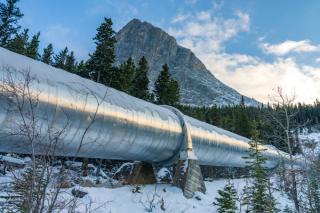
Laying the groundwork: Geotechnical considerations for resilient pipelines
- Post Date
- 23 July 2025
- Read Time
- 4 minutes

In the energy sector, pipelines are critical infrastructure, transporting resources across landscapes that vary from open prairies to rugged mountains. While the pipeline itself often takes center stage, it’s the ground beneath that can ultimately determine a project’s success. That’s where geotechnical engineering becomes essential.
Successful pipeline development depends on a detailed understanding of subsurface conditions and identification of risks that enable smart design to support long-term infrastructure performance. For pipeline developers and operators, geotechnical considerations offer the foundation needed to support integrated design and construction, and maintain infrastructure that’s safe, durable, and regulatory-compliant.

Mitigating Risk Below the Surface
Pipeline projects face unique and evolving challenges—unstable terrain, shifting surface and groundwater, seismic activity, and environmental sensitivity, to name a few. Geotechnical engineers help identify, assess, and recommend solutions to mitigate risks to ensure safety, reliability, and regulatory compliance throughout the pipeline’s lifecycle.
Key client solutions include:
- Route Selection Support
Early-stage desktop studies and terrain evaluations help identify feasible routes that minimize geohazards and reduce design and construction complexity and cost. - Subsurface Investigation and Characterization
Boreholes, test pits, and geophysical surveys provide critical information about soil, rock, groundwater, and permafrost conditions, informing and shaping both design and construction decisions. - Slope Stability Assessment & Erosion Control
For pipelines traversing hilly or mountainous terrain, understanding the subsurface conditions and potential mechanisms of failure are fundamental in assessing slope stability that is vital to avoid failures that could threaten the integrity of the pipeline. - Seismic & Geohazard Assessment
Identifying and evaluating the presence landslide-prone areas, dynamic ground condition and liquefaction potential is essential for safe pipeline routing and resilient pipeline design. - Trenchless Technology Design Support
Techniques like horizontal directional drilling (HDD) require precise geotechnical data for successful crossings under rivers, roads, or environmentally sensitive areas.

Supporting the Full Lifecycle
Geotechnical involvement doesn’t end once a pipeline is in the ground. Throughout the operational life of a pipeline, ongoing monitoring and risk management help maintain performance, address evolving ground conditions, and ensure long-term safety and reliability. Key areas of ongoing support include:
- Instrumentation & Monitoring
Installing and interpreting data from inclinometers, piezometers, and other monitoring tools to measure and track ground movement and changes in pore water pressure. - Asset Integrity & Risk Management
Assessing changing conditions due to climate, land use, or aging infrastructure that might affect pipeline performance, especially in aging infrastructure - Remediation & Stabilization
When issues emerge, our team collaborates with operations to develop practical, cost-effective solutions to stabilize slopes, reroute lines, or manage ground-related risks. - Pipeline Vibration and Stress Analysis
Analysis that focuses on how ground-related factors contribute to stresses and movements in a pipeline system. This includes assessing how soil–structure interaction, ground vibrations, loading and geohazards (like landslides, settlement, or seismic activity) influence pipeline integrity.
Building a Resilient Future from the Ground Up
Geotechnical input isn't just another project requirement—it’s the foundation of long-term pipeline reliability.
Planning a pipeline project? Get in touch.
Our integrated, multidisciplinary approach brings together geotechnical, geohazard, hydrotechnical, environmental, and permitting specialists. Whether it's a new greenfield development or the rehabilitation of legacy infrastructure, our team supports each stage with responsive, site-specific solutions.

